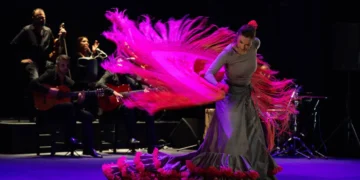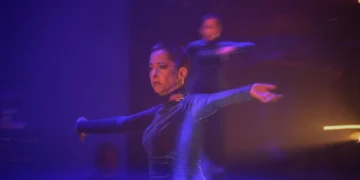|
XV FESTIVAL DE JEREZ
|
|
Text: Estela Zatania LUIS MONEO On Wednesday afternoon, the last recital of acoustic cante in this edition of the Festival de Jerez, took place in the intimate salon of the Palacio Villavicencio. Jerez singer Luis Moneo, with his son Juan Manuel on guitar, and daughter-in-law María José Franco providing palmas, offered a sober exhibition of his art and knowledge worthy of his family name. The man from San Miguel, the historic Jerez neighborhood of blacksmiths, fish-mongers and excellent singers, opened with cantiñas, a form he knows well thanks to years of singing for dance, although it’s always surprising to hear the aggressive Jerez delivery applied to the delicate cantes of Cádiz. Luis’ sincere way of singing gave warm dimension to the malagueñas of Mellizo – rarely do you hear other malagueñas in Jerez or Cádiz, despite the dozens of forms that exist – and ended with rondeña and the fandango of Frasquito. In soleá, he sang with restraint, showing the specific gravity typical of the Moneos, and then, siguiriyas and toná liviana in the style of Mairena, with the guarantee of his neighborhood and family. Bravely, he interpreted two martinetes before letting loose a gust of bulerías with the accent on San Miguel styles, the characteristic bulerías that linger in C and Bb, creating a kind of tension not to be found in the festive cante of other places. COMPAÑÍA BELÉN MAYA “TRES” Belén Maya is one of oldest of the new wave of flamenco dancers, and one of the most admired and accomplished. It’s hard to understand why her show “Tres”, which debuted a month and a half ago at the Nimes Festival in France, was not presented at the Villamarta Theater which would easily have filled up for the daughter of Mario Maya and Carmen Mora. In any case, the word “debut” is strange in this case, because the title “Tres”, or “three” refers to the three artists who deliver its content, in other words, singer Jesús Méndez, guitarist Rafael Rodríguez and dancer Belén, with no more accompaniment that the palmas and short dance bits of Felipe Mato. The three elements of flamenco ever since the Big Bang have now become so rare the enterprise requires a title. “Fascinating” is the adjective that best describes this dancer who is constantly experimenting, even right on stage. An odd gesture of hands and wrists that had begun to appear in Nimes, is now barely present. The first number has taken on more life, depending more on dance now and less on pantomime, which is a positive modification. For the hundredth time I have to complain about the insufficient lighting of many current flamenco shows, something which is often commented on in the foreign press as well. It’s possible that down in the expensive seats you could she the faces of the performers, and their small movements, but up in the peanut gallery is was at times hard to distinguish dance moments from stagehands-moving-props moments. Relief was total, though brief when we were allowed to see Belén’s alegrías in all her glory, with subtle and efficient details, and the delightful retro guitar-playing of Rafael Rodríguez. Jesús Méndez does a fine job singing for the dance, and with several cantes on his own, although it would have been nice to have another singer for variety. But of course then you’d have to change the name of the show to “Four”, and it would be an entirely different concept. Belén dances tangos, once again with very little light, speaking to us with her Granada body language and coming through loud and clear. She molds time, stops it, makes it go in reverse, she gives us a tweak, laughs…it’s an intimist, almost innocent style, without the anguish often associated with flamenco. The tangos morph into taranto and cartegenera. Felipe Mato is a kind of danced Greek chorus, filling in the down time, justifying Belén’s absence from the stage and acting as a bridge between numbers. Siguiriyas, romance, caña…and again there’s a shawl dance – we can all be glad this accessory is coming back into flamenco fashion. Bulerías por soleá around a wooden table (now almost obligatory for these cantes), Belén joins the scene and thus the show called “Tres” winds up its flamenco journey through the Festival de Jerez 2011. |
Descubre más desde Revista DeFlamenco.com
Suscríbete y recibe las últimas entradas en tu correo electrónico.




























